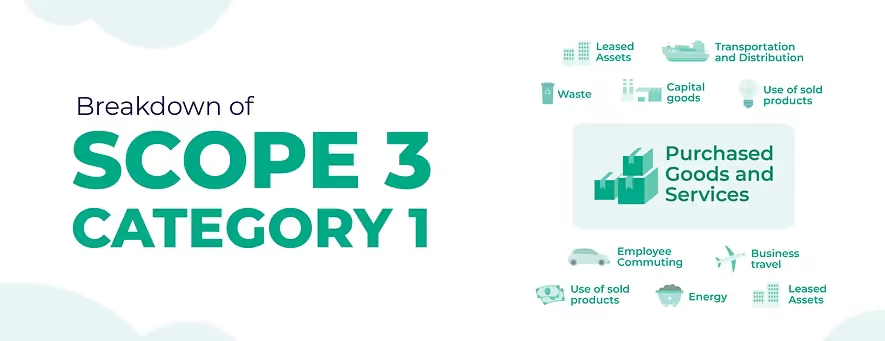
Solutions
Carbon Management
ESG Intelligence
Climate & Nature Risk
Data Registry
Beta
Sector
Get started, schedule a demo or request a free assessment!


Understanding where your true emissions footprint lies is key in the intricate labyrinth of climate action. While direct emissions (Scope 1) and energy-related ones (Scope 2) hold the spotlight, the hidden villain often lurks in the shadows: Scope 3 emissions. And within this enigmatic realm, Category 1: Purchased Goods and Services reigns supreme, dwarfing your operations' combined impact and electricity use (World Resources Institute, 2023). Today, we deeply dive into this crucial category, revealing its intricacies and exploring strategies to tame its beastly impact.
Imagine the colossal chain reaction triggered by your cup of morning coffee. From cultivating the beans to brewing the final cup, emissions are generated at every step – emissions you're indirectly responsible for. Scope 3, Category 1 captures these upstream emissions embedded in the goods and services you purchase. This category includes all upstream (i.e., cradle-to-gate) emissions from producing products purchased or acquired by the reporting company in the reporting year. Products include goods (tangible products) and services (intangible products). Cradle-to-gate emissions include all emissions that occur in the life cycle of purchased products, up to the point of receipt by the reporting company (excluding emissions from sources that are owned or controlled by the reporting company) (Greenhouse Gas Protocol, 2022). It encompasses everything from the raw materials in your laptop to the transportation your deliveries take (CDP, 2023).
The invisible footprint of purchased goods and services looms large across industries. For manufacturers, these emissions can comprise over 80% of their total footprint (GHG Protocol, 2022). The paper and IT services they rely on in the finance sector contribute significantly. (CDP, 2023). Even seemingly service-oriented sectors like healthcare, and medical equipment, rack up considerable emissions (World Business Council for Sustainable Development, 2020).
Ignoring Scope 3, Category 1 emissions is akin to painting a rosy picture with half the canvas covered. By failing to account for them, you underestimate your true climate impact and risk jeopardizing your sustainability goals (WBCSD, 2020). These emissions contribute substantially to global warming, and tackling them head-on is crucial for a truly responsible and impactful climate strategy (IPCC, 2022).
By unearthing the truth of your Category 1 emissions, you unlock the power to:
By acknowledging and tackling this hidden giant, you unlock innovation, collaboration, and responsible leadership in the race for a sustainable future.
Measuring Category 1, Scope 3 emissions requires careful attention to detail, whether you're following the Greenhouse Gas Protocol (GHG Protocol) or the International Organization for Standardization (ISO) standards. Here's a breakdown of the main approaches:
When analyzing Category 1, Scope 3 emissions and setting targets for value chain sustainability, you can delve into several key areas such as mapping your supply chain by using metrics such as absolute emissions from each good or service purchased, and intensity as per unit good or service purchased or monthly and seasonal changes in the emissions from each good and service purchased.
Set internal science-based targets to reduce Scope 3, Category 1 emissions by supplier engagement and other means that align your reduction goals with the Science Based Targets Initiative (SBTi) to ensure they are ambitious and contribute to global climate goals.
Demystifying your hidden footprint requires a deep dive into Category 1 emissions. Map your supply chain landscape using multiple metrics: absolute emissions per good or service, emission intensity per unit, and even temporal trends exposing seasonality or fluctuations. Categorize your purchases by type and emission impact, making it easier to prioritize high-impact areas. Identify key suppliers whose emissions loom large, then decipher their processes to pinpoint specific hotspots. Finally, set ambitious, science-based targets aligned with the Science Based Targets Initiative (SBTi). Engaging your suppliers and implementing targeted reduction strategies will help you tame the category 1 beast and unlock value chain sustainability.
The battle against Category 1 emissions demands innovation and collaboration. Let's explore diverse strategies companies and governments can wield to conquer this hidden giant:
Remember, reducing Category 1 emissions is a marathon, not a sprint. By combining these strategies, fostering collaboration, and embracing continuous improvement, businesses and governments can become champions in taming the Category 1 beast, paving the way for a sustainable future.
StepChange empowers you to see through your blind spots and unlock real sustainability beyond your walls. Our data-driven platform unveils all the emission hotspots in your supply chain by calculating your Scope 3 emissions across categories. StepChange’s ESG Software helps you pinpoint emission hotspots, prioritize actions, and collaborate with suppliers to drive reductions through your entire value chain. With ESG Software, you can set ambitious, science-based targets that showcase your climate leadership attract conscious consumers and investors, and analyze your baseline to start improving!

.svg)